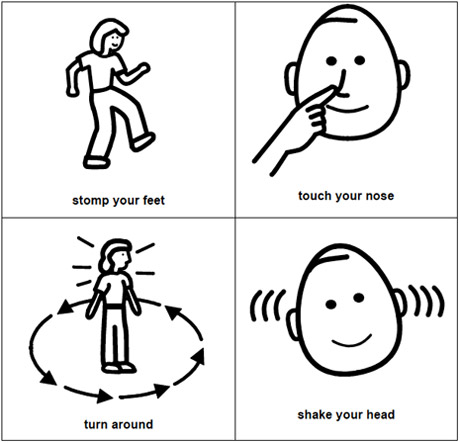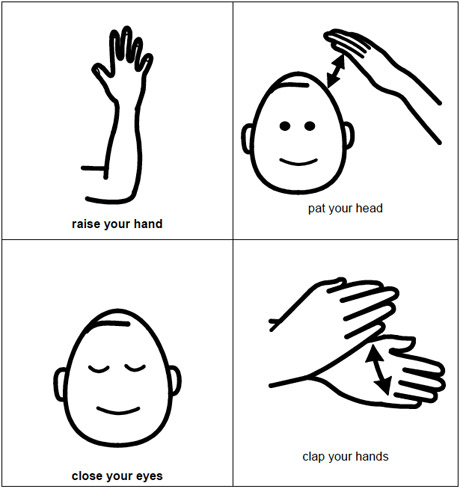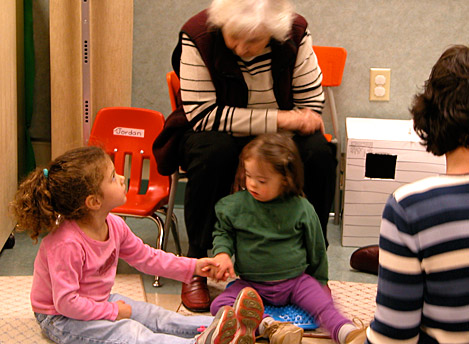
“YES, My Child Belongs”
A parent handbook to help with understanding special education in Toronto and to ensure the acceptance and belonging of children with additional learning support needs.
Prepared by Community Living Toronto, 2009
You will find information on:
The information in this handbook was prepared by members of the Education Committee of the Community Living Toronto Board of Directors. To the best of our knowledge the information in this handbook is accurate but should be used as a guide only. We will try to provide updates as procedures, systems, or legislation changes. Please watch for updates on our website www.communitylivingtoronto.ca
Registering for School
Kindergarten
Registration for kindergarten in both the Toronto District School Board (TDSB) and the Toronto Catholic District School Board (TCDSB) usually begins early in the calendar year. Most schools schedule specific days for registration (generally begins in February); you should call your local school to determine the dates they have set. Should you miss this registration period you can contact the school at any time. However, DO NOT wait until the beginning of the school year to register your child or to discuss their support needs.
- For Junior Kindergarten the child must be turning 4 before December 31st and for Senior Kindergarten the child must be turning 5 before December 31st.
- Parents register their child at the neighbourhood school (the school that is closest to your home). The school cannot refuse to register your child because they have special needs. This is the same whether you are looking for a regular class or special education placement
- If your child attends a child care program that is located within an elementary school building, this school becomes your home school as long as your child is in that child care
- At the time of Registration, Community Living Toronto staff recommends that you tell the board staff that your child has special support needs and that you request a meeting, at another time with the principal.(see meeting with the principal)
- All parents are required to bring several pieces of information:
- Proof of Age (Birth Certificate);
- Proof of Citizenship or Permanent Resident Card, (there are different registration requirements for families who do not have Permanent Resident Status)
- Proof of Immunization (yellow card from the doctor)
- Proof of custody (if applicable)
- Proof of address (e.g. phone bill, lease, etc.)
- Catholic schools will require proof of baptism.
Registering an Older Child
If you are registering an older child, (e.g. transferring from another school) follow the same procedure as outlined above. It is recommended that you contact the school as soon as you know your child will be attending that school. If possible, do not wait until the beginning of the school year to register your child or to discuss their support needs.
Meeting with the Principal or Vice Principal
Effective Communication
In the Ministry of Education’s “Shared Solutions Document” (see resources below) schools need to promote a “positive school climate”. Achieving and maintaining a positive school climate requires teamwork from educators, parents and students. Effective communication is the key to building relationships of mutual trust and cooperation. It is critical that you help the educators see your child from your perspective. Understanding each other will help everyone to acknowledge the differing experiences and perspectives as well as the contributions of everyone involved with your child. When everyone acknowledges and respects these perspectives, it is possible to arrive at a shared solution, including an enhanced positive school climate and better relationships.
If the lines of communication are open, you should feel at ease about contacting your child’s teacher to discuss progress or concerns that may arise. When people have a comfortable relationship, they are more willing to ask questions, offer opinions and discuss options in an open, honest way.
Open dialogue can lead to mutually acceptable solutions.
Differences in opinion can represent an opportunity; if everyone responds constructively, creative solutions can be found.
Introduce your child in a positive manner
It is important that you help the school to see the strengths and capabilities of your son or daughter. Focus on what your child can do. Think about the times when your child does NOT need extra help. What are the specific activities, locations, etc. in which he/she is already successful without extra support? What strategies work well to assist your child to learn and to participate? Tell stories about things that your child has learned, what they enjoy doing, what programs they have attended, and what they can do independently. While it is important that you are honest with the school regarding the extra support your child may need to be successful, keep the focus on your child’s ability to learn.
At this meeting, share all relevant information or reports that outline your child’s strengths, learning styles, and areas that will require additional support.
It is important that you build a positive relationship with both the principal (or vice-principal) and the teacher. Parents are encouraged to think of this time in their child’s life as a new partnership with the school. When talking to school staff, stress the point of partnership and collaboration and explain that you want to be consulted about all decisions and that you will be actively involved in all aspects that will affect your child’s education. It is critical that you keep the communication channels open. Offer to meet or exchange written or verbal communication with them regularly. You can request a separate meeting to discuss a plan to ensure a smooth transition for your son or daughter from their current childcare arrangement to kindergarten.
Student Supports
- School Boards assign resources to a school based on the needs of all students within that school. It is then the responsibility of the principal to assign the job duties of the assistants where they feel they are most needed. It is the responsibility of the parent to ensure the principal has a thorough understanding of the strengths, and support needs (these may include health, medical, safety, academic etc.) of their child
- Encourage everyone involved with your child to think creatively about the types of supports available within the school, other than paid educational assistants. These may include:
- students from other grades
- volunteers
- parents (other than yourself)
- friends from their class
- resource teachers
Resources:
The Toronto Catholic District School Board and the Toronto District School Board have information on schools in your area and registration requirements on their website.
TCDSB – www.tcdsb.org
TDSB – www.tdsb.on.ca
ConnectABILITY – www.connectability.ca
Ministry of Education –
Planning Entry to School – A Resource Guide (2005) http://www.edu.gov.on.ca/eng/parents/planningentry.html
Special Education in Ontario: Kindergarten to Grade 12
http://edu.gov.on.ca/eng/document/policy/os/onschools_2017e.pdf
Shared Solutions: A Guide to Preventing and Resolving Conflicts Regarding Programs and Services for Students with Special Education Needs
www.edu.gov.on.ca/eng/general/elemsec/speced/shared.pdf
Kindergarten Program
http://www.edu.gov.on.ca/eng/curriculum/elementary/kindergarten.html
Identification Placement Review Committee (IPRC)
What is the Purpose?
The purpose of an IPRC meeting is to discuss the exceptionality (the type of disability) and the educational placement of a student. Placements will be either in a regular class or a special education class. If the recommendation is for a special education class, the board must provide written reasons for this recommendation. Placements are required to be reviewed at least once each school year; this usually occurs in the spring of each year, unless the parent provides the principal with written notice dispensing with the review.
What is required from the School Board?
- School Boards must give you 10 days notice, in writing, of the date of the meeting. If you cannot attend the meeting you should let the principal know as soon as possible so that another date and/or time can be arranged.
- The notification of the meeting date is to be accompanied by the School Board’s “Parent Guide to Special Education”. As well, this document is available at every school or may be downloaded from the Board of Education web sites.
- 5 days before the IPRC, the parent should receive a copy of any information about their child that the Chair of the IPRC has received and the committee will be considering
- To provide an interpreter if you require and request one
How is my child referred to an IPRC?
- You may ask that your child be referred to an IPRC by informing the principal of your request, IN WRITING. The principal must honour this request and cannot deny an IPRC. The principal must respond within 15 school days giving you an approximate date for the IPRC.
- A school principal may, upon written notification to you, refer your child to an IPRC when the school staff believe your child will benefit from a special education program
- You can request a review IPRC every 3 months
What are the Parents’ rights?
- Parents have the right to be present and participate in all discussions and decisions about their child. Do not hesitate to ask for clarification during any discussions. (If the scheduled time of the IPRC is not convenient for you, notify the principal as soon as possible to make alternate arrangements)
- Community Living Toronto strongly recommends that parents always attend the IPRC meeting and that parents should never sign the form giving permission for the IPRC meeting to happen without them present.
- Government regulations state that if you want your child in a regular class, you have the right to request this placement. The IPRC is required to consider placement in a regular class before making a recommendation for a special education class placement. If a decision is made in favour of a special education class, the IPRC must state the reasons for this on the decision sheet.
- You have the right to have a person(s) present who may provide you with support. Community Living Toronto strongly recommends that you take someone with you, even if it is just to listen, take notes, or help you remember and understand what happens at the meeting.
- You are to receive all information that the IPRC will be considering, during the meeting at least 5 days before the meeting
What to expect from the meeting?
- The meeting begins with a discussion of the strengths and needs of your child. Annual review meetings should also include a discussion of the achievements that occurred during that school year.
- The IPRC members will then discuss the type of placement they feel will best meet the needs of your child. Be sure that you request the type of placement you desire for your child.
- In making its decision, the IPRC may consider a range of options, but must consider regular class as the first choice. The other options include:
- A regular class with indirect support. The student is placed in a regular class for the entire day, and the teacher receives specialized consultative services.
- A regular class with resource assistance. The student is placed in the regular class for most or all of the day and receives specialized instruction, individually or in a small group, within the regular classroom from a qualified special education teacher.
- A regular class with withdrawal assistance. The student is placed in the regular class and receives instruction outside of the classroom for less than 50% of the school day, from a qualified special education teacher.
- A special education class with partial integration. The student is placed in a special education class for at least 50% of the day, but is integrated with the regular class for at least one instructional period daily.
- A special education class full time. The student is placed in a special education class for the entire school day.
Understanding “Special Education Program” vs. “Placement”
- A special education program is a plan based on and modified by results of continuous assessments and evaluations to meet the needs of the student (see IEP section)
- Placement is the physical location that the student attends school, either in the regular class in the neighbourhood school or a special education class
The IPRC Decision Sheet
The IPRC decision sheet will include the following information:
- Whether your child has been identified as exceptional and the category as defined by the Ministry of Education
- A description of the strengths and needs as described during the meeting
- Placement decisions, including reasons if the recommendation is for a special education class
- Recommendations with regards to special education programs and services
The Review IPRC
- The Review IPRC is conducted in the same manner as the original one and must discuss, strength and needs, exceptionality, and placement
- Parents can request a discussion of support services and have these recommendations included on the second page of the IPRC decision sheet
Other suggestions for parents
- You may wish to bring a picture of your child to the meeting. This will help to remind committee members that they are discussing a person not just a placement, especially as some of the professionals may not have met your child.
- Community Living Toronto recommends that you focus on the positives of your child and that you stop conversations that are focusing only on the negative by asking people to talk about accomplishments and what has worked.
- Community Living Toronto also recommends that parents do not sign the paperwork presented in the meeting, but instead, take it home, review it and make sure that you understand what has been recommended.
- Any additional information that you want included with the IPRC decision sheet (e.g. additional strengths/needs; service recommendations etc.) must be attached using the Ministry of Education language as an “addendum”.
- The strengths and needs from the IPRC decision sheet, are used as the basis for the development of the IEP (see next section)
- There is also an appeal process in the event that you disagree with either the exceptionality or the placement decision. This process is outlined in both the parent guide from the boards of education and in the Ministry of Education documents as listed below.
The School Day
The Education Act requires that children over the age of 6 attend school for a full day. It defines a “full day’ as 300 instructional minutes. This does not include recesses or lunch breaks.
If your child has medical concerns or is unable to cope with the full day, there is a provision for their school time to be shortened. School boards cannot use lack of support, or funding as a reason to shorten a student’s day.
Resources
The Ministry of Education website has information available on the IPRC process, how the process should work, and if necessary the appeal process.
Highlights of Regulation 181/98
www.edu.gov.on.ca/eng/general/elemsec/speced/hilites.html
Special Education in Ontario: Kindergarten to Grade 12
http://edu.gov.on.ca/eng/document/policy/os/onschools_2017e.pdf
Shared Solutions: A Guide to Preventing and Resolving Conflicts Regarding Programs and Services for Students with Special Education Needs
www.edu.gov.on.ca/eng/general/elemsec/speced/shared.pdf
TDSB – Parent guide: Link
TCDSB – Parent guide: Link
ConnectABILITY – www.connectability.ca
Individual Education Plans (IEP)
What is an IEP?
- An IEP is a written plan of learning goals and expectations for a student who requires modifications or accommodations to the regular school program. These goals and expectations may differ from those defined in the appropriate grade level of the Ontario curriculum.
- An IEP describes the strengths and needs of an individual exceptional pupil, the special education program and services established to meet that student’s needs, and how the program and services will be delivered. It also describes the student’s progress.
- IEP’s are required for any child who has been identified through the IPRC process. However, a student who has not been identified may also receive an IEP.
- IEP’s are to be completed within 30 school days of the start of a placement; this is usually at the start of the school year.
- Principals are legally required to make sure that, as a parent, you are consulted in the setting of the IEP goals. (The IEP Resource Guide and the Shared Solutions documents elaborate on the consultative and cooperative approach that should be used.)
- The IEP is required to be reviewed at each report card time and revised to reflect progress; or to break the goals into smaller steps if learning is proceeding at a slower rate. The grade on the student’s report card for subjects identified in an IEP should be based on the learning goals in the IEP.
What does an IEP look like?
- The IEP will include the exceptionality as stated in the IPRC, the type of placement, any relevant medical or assessment data, the subjects to which the IEP applies and the student’s strengths and needs.
- IEP’s should only contain subjects or goals that are different from everyone else in the class.
- The IEP will identify whether each subject or goal in the IEP will differ from the Ontario curriculum by being modified or by applying accommodations, or whether the goal is an alternative to the curriculum.
- Accommodated – refers to subjects/courses in the Ontario curriculum that require accommodations only for the student to access the regular grade expectations. For example, more time to write tests, allowing oral responses, or using audio-visual equipment in class.
- Modified – refers to subjects/courses from the Ontario curriculum that require the development of modified expectations that differ from the regular grade expectations. The student may also require specific accommodations for these subjects/courses.
- Alternative – refers to programs that assist students to develop skills/knowledge and that are not included in the Ontario curriculum. Examples of alternative programs include: speech/language therapy, occupational therapy, behaviour management or personal care programs.
- Learning expectations are to be written in such a way that you are able to understand exactly what they mean. They must be observable and measurable
- In addition to goals or learning expectations, the IEP should also include what strategies the teacher will use and how the student’s knowledge will be assessed, as well as the current level of achievement, which acts as a baseline from which to measure progress.
Transition Plans
Every identified student who is 14 years of age or older, is required to have a Transition Plan. The purpose of this plan is to ensure that the student is prepared to meet post-secondary goals, such as work, further education, and community living.
Transition plans must contain:
- Specific goals that are realistic and reflect the strengths, needs and interests of the student
- The actions required, now and in the future, to achieve these goals
- The person (people) or agency responsible or involved in completing or assisting in the completion of each goal
- Timelines for the implementation for each of the identified actions
Resources
The Individual Education Plan (IEP): A Resource Guide (2004)
www.edu.gov.on.ca/eng/general/elemsec/speced/guide/resource/iepresguid.pdf
Special Education in Ontario: Kindergarten to Grade 12
http://edu.gov.on.ca/eng/document/policy/os/onschools_2017e.pdf
Shared Solutions: A Guide to Preventing and Resolving Conflicts Regarding Programs and Services for Students with Special Education Needs
www.edu.gov.on.ca/eng/general/elemsec/speced/shared.pdf
Learning for All
http://www.edu.gov.on.ca/eng/general/elemsec/speced/LearningforAll2013.pdf
The Ministry of Education publishes curriculum expectations for every grade, these are available at:
www.edu.gov.on.ca/eng/parents/curriculum.html
Secondary School
As your child enters the later years of elementary school (grade 7 & 8), you will need to begin to think about the next phase; secondary school.
- Talk to other parents in the area, guidance counsellors, special education department staff etc. about the kinds of programs and/or courses that are available at that school.
- Attend information sessions hosted by the school for parents of grade 8 students. This is an important time for you to explore the options available.
- Students with special education needs are legally entitled to remain in school until June of the year in which they will turn 21.
Graduation
There are three ways in which student achievement is recognized in Ontario.
- The Ontario Secondary School Diploma (OSSD) is granted to students who earn a minimum of 30 credits , pass the secondary school literacy test and complete 40 hours of volunteer community service
- The Ontario Secondary School Certificate (OSSC) is given, on request, to students who are leaving secondary school with a minimum of fourteen credits (7 of which are compulsory and 7 that are optional credits)
- Students who leave school before fulfilling the requirements for the OSSD or OSSC may be granted a Certificate of Accomplishment. This certificate may be used to recognize achievement for students who plan to take certain vocational programs or other kinds of further training, or who plan to find employment after leaving school.
Resources
Ministry of Education – Ontario Secondary Schools, Grade 9 to 12 Program and Diploma Requirements http://www.edu.gov.on.ca/eng/document/curricul/secondary/oss/oss.pdf
Ontario Student Record – OSR
- The OSR is the ongoing, confidential record of a student’s progress throughout school. It is filed in the school office. All students and their parents (if the student is under 18 years of age) have a right to review the contents.
- The OSR file may include:
- Identifying information such as name, address, telephone numbers, and emergency contacts, as well as a picture of your child.
- Report Cards
- Any additional information considered relevant for improving the instruction of the student
- If, in examining your child’s OSR, you feel that certain kinds of information are not relevant, you may submit a written request to the principal asking to have it removed.
General Resources
Complete information on the OSR is available on the Ministry of Education website at:
www.edu.gov.on.ca/eng/document/curricul/osr/osr.html
Documents related to the Ontario Human Rights Code are available at:
http://www.ohrc.on.ca/english/index.shtml
All Ministry of Education documents are available at the Government bookstore or may be downloaded from the Ministry of Education website: www.edu.gov.on.ca
Community Living Toronto
www.communitylivingtoronto.ca
Membership Services: 647-426-3220
Education Liaison; Tracey O’Regan 416-371-3162
Holland Bloorview Kids Rehabilitative Hospital
Phone: 416-425-6220
www.hollandbloorview.ca
Canadian Association for Community Living & the Roeher Institute
Phone: 416-661-9611
www.cacl.ca
CACL – Inclusive Education Canada
www.inclusiveeducation.ca
Community Care Access Centres
Phone: 416-506-9888
healthcareathome.ca/
Community Living Ontario: Education Advocacy
An inclusion resource library. https://communitylivingontario.ca/en/inclusive-education/
Phone: 416-447-9576
www.communitylivingontario.ca
ConnectABILITY
www.connectability.ca
Down Syndrome Association of Toronto
Phone: 416-966-0990
http://dsat.ca
Extend-A Family
Phone 416-484-1317
www.extendafamily.ca
Family Alliance Ontario
Phone: 416-661-9611
www.family-alliance.com
Geneva Centre for Autism
Phone: 416-322-7877
www.autism.net
Ontario Coalition for Inclusive Education
Phone: 416-531-8553
www.inclusive-education.ca
Ontario Ministry of Education
Mowat Block, 900 Bay Street
Toronto, Ontario ,M7A 1L2
Phone:(416) 325-2929 or 1-800-387-5514
www.edu.gov.on.ca
Parent Outreach Program
Phone: 416-645-6000 ext. 1167
www.woodgreen.org
People First of Ontario
Phone: 416-441-6172
Surrey Place Centre
Phone: 416-925-5141
www.surreyplace.ca
Toronto Catholic District School Board
Phone: 416-222-8282
www.tcdsb.org
Toronto District School Board
Phone: 416-397-3000
www.tdsb.on.ca
Toronto Family Network
Phone: 416-484-1536
e-mail: torontofamilynetwork@gmail.com





